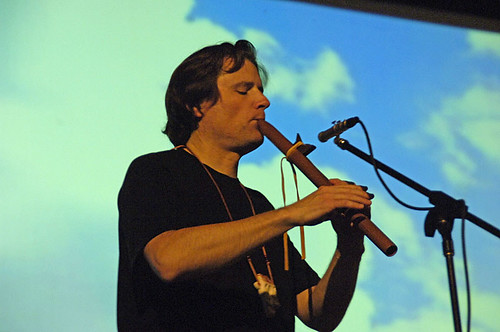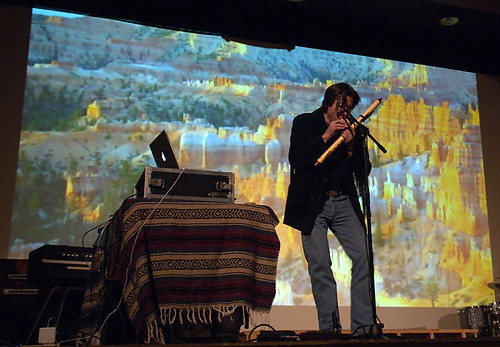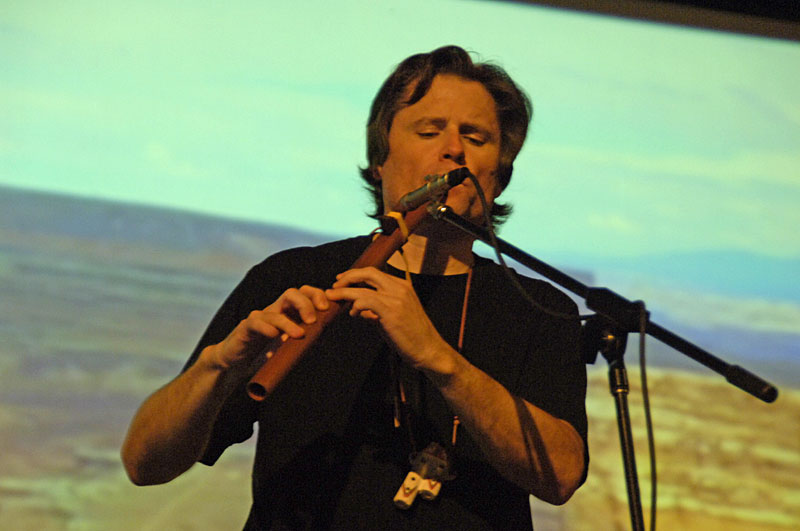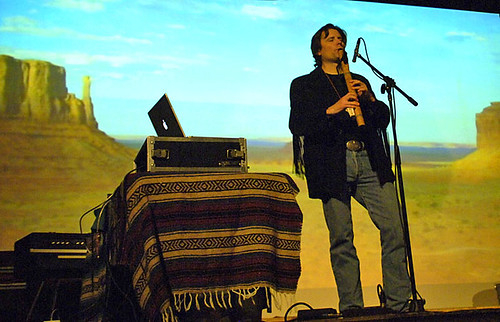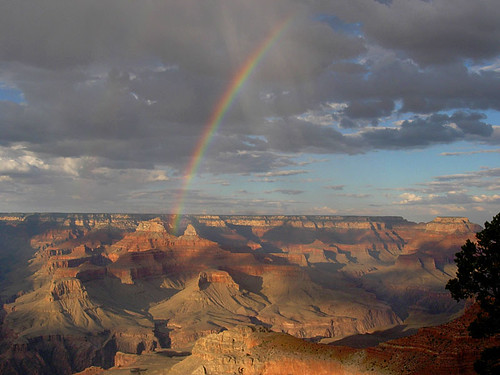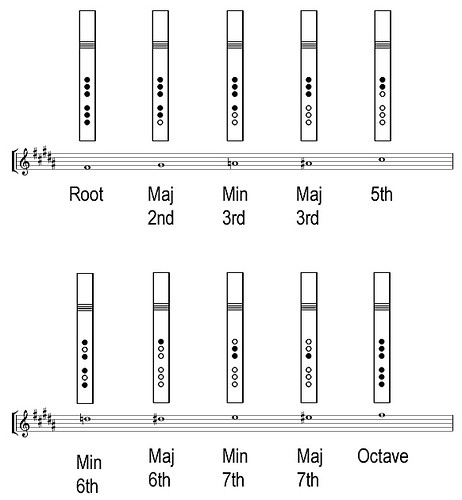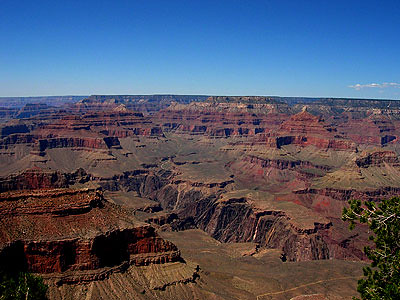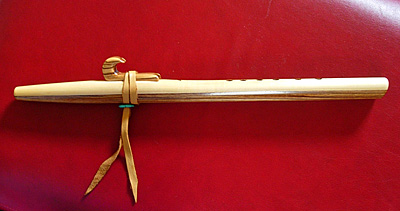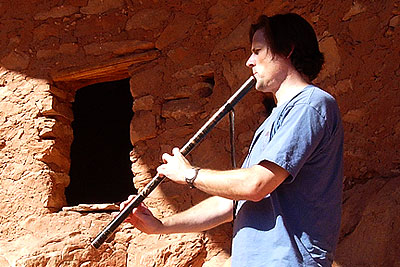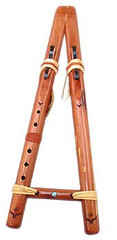Many of you have asked me to talk about my recordings in depth. The biggest question is "
What flute did you use on a certain song?" or "
What key is that piece in?". I don't include this information in the CD booklet as I feel that it takes away from the magic of the music to transport the listener if there is too much technical information. Also, most of the people that listen to my music aren't musicians and don't care that much. But for those of you that do, I thought my blog would be the perfect place to talk about this.
Here is a look at
Lost Canyons.

Lost Canyons
Track 1
Morning Star
This piece features an Anasazi flute in the key of A flat. As the basic scale of the Anasazi flute, as well this song, is in a major pentatonic scale I prefer to think of this piece being in Ab rather than G sharp. (Michael Graham Allen the maker of the flute calls these flutes G sharp.) Ab major has more of the tones found on this flute without having to call notes like C, the very akward name B sharp. The piece has two themes which are repeated. At the end of the piece we think that we're going to hear the opening theme again but instead we get a subtle key shift to the minor and the flute part fades out. Behind all this is a building texture of sound that was generated using different delays and reverbs, including some DP plug-ins and an Eventide box.
Morning Star is, like dawn, is at the beginning of our journey. Both the morning star and evening star have great symbolism in many Native cultures who did not see them as one star, Venus, but rather two different bodies in the sky. To the pueblo people they represent the Little War Gods, sons of the Sun, and escort the him on his journey across the sky. The Little War Gods are twins and are part of the warrior pantheon of Pueblo deities. The Aztec and other Meso American cultures also saw Venus as war like as well. The appearance and movement of Venus foretold danger and warfare. Like Pueblo culture the morning star and evening star were thought to escort the Sun. The morning star would lead the sun up from the underworld, while the evening star would lead it back down to the underworld. There are also classic Mayan inscriptions that record wars timed to coincide with the movements of the morning star and evening star. These so called "Star Wars" seemed to occur most frequently with the morning star.
The symbolism of the morning star and evening star are well represented in the Popol Vul, the Mayan account of creation. After the creation of the world, but before the Sun appears in the sky the legendary hero twins, Hunahpu and Ixbalanque defeat the lord of the underworld Xibalba. Their journey takes them down into the underworld to pass tests that Xibalba puts to them. They use great cunning to pass these tests. They also defeat Xibalba in the ancient balls games of the Mayan, Aztec and even Southwestern prehistoric cultures. The ball is thought by some to symbolize the sun. Finally Hunahpu and Ixbalanque are killed by Xibalba only to be reborn and kill him. With their rebirth comes the first appearance of the Sun over the earth.
Lost Canyons
Track 2
Raven Dance
This piece is in D minor pentatonic. (From now on unless I mention other wise, all keys will be a minor pentatonic scale.) This flute is a wonderful flute made by Geoffrey Ellis out of tiger eye maple and ivory. The block is, to my eyes, an abstract raven. Geoffrey's flutes have the mellow sound called Woodland and are some of the best flute made in that style, or any style. They have a warm, rich, full tone that every flute player should have in their arsenal of flutes.
This song got it's start on the dinning room table of a friend of mine. I wanted to explore in more depth a program called Reason. So one weekend while hanging out I set up my laptop and hooked up a small M-Audio keyboard to it and began to delve into it. Reason has been around for a while and I'd used it on New Fire but I'd never really gotten deep into it. So this piece began as an experiment. I started working with different drums and added some middle eastern lutes and South American guitars and then the piano part. As I wrote each new part I very quickly realized that I had the makings of a song. Out of habit I was using DP to record all the parts so it wasn't that hard to transfer the file and it's sounds to my studio computer in order to start working on the flute melody.
The flute melody is based on an idea I'd already been working on and it fit the mood of the rhythms I had written that afternoon on the dinning room table.
Like a lot of the pieces on Lost Canyons there are a lot of underlying textures running beneath this tune just like Morning Star.
A quick thought about the title. I love ravens. They are the quintessential bird of the Southwest. They abound in Native lore from all cultures as Gods, tricksters, creators, clowns, sages and messengers. I've watched them do barrel rolls over my truck as they pass over head on the highway, hover on the breeze that swirls around buildings and cliff faces and have witnessed pairs join talons in flight, falling to the earth until at the last moment breaking apart and soaring away, like some choreographed dance.
In the song description found in the CD booklet there is a riddle about two very well known ravens. Perhaps you can guess it. (Very raven like to have a riddle for these ultra intelligent creatures.)
Lost Canyons
Track 3
Desert Skies
This piece does not have any flutes on it. Like many of my songs it started out with a sound and a space. In this piece it was a guitar run through some really big sounding reverb and delay effects. In the end almost everything was run through this same set of effects. The gamelan has it's own delay.
Sometimes the best ideas can come from your mistakes. In this case I had one of the reverbs set to a mono input when I thought I had it set to stereo. Once I discovered this and changed it to stereo, it lost some of it's sense of space. The sound got "flatter", so I switched back to mono, the setting I didn't think I wanted!
Lost Canyons
Track 4
Where Spirits Dwell
An Ab Anasazi flute carries the melody of this piece. Under this is a conga part that has it's own built in delay to propel the rhythms and some shakers that bounce around the stereo field. The middle section is all gamelan with an underlying pulse made up from a small riff that comes alive through some really extreme delay effects.
The title of this work comes from a trip I made to a place called Mystery Valley, which is a sub section of Monument Valley and you have to go in with a Navajo guide. The area is full of Anasazi or Ancestral Puebloan dwellings. One of the largest is set at the base of a two hundred foot cliff. Behind the ruin on the face of the sand stone cliff are hundreds of hand prints put there by the people that once live and or visited there. Other rock art shows that the Ancients had lived there as far back as 1,500 hundred years and more. It's called the House of Many Hands and to me it's one of the places on in the Southwest Where Spirits Dwell.
Lost Canyons
Track 5
Swallows & Nighthawks
The first of four pieces to feature a flute made by a maker from Arizona. In this song it's an F sharp flute made by J.P. Gomez. In my opinion J.P. is one of the best NAF makers working today. Every flute I have by him has a wonderful clear, singing tone and they are some of the best tuned flutes I own. They are great flutes and I believe no collection is complete without a flute by him.
This solo was inspired by a hike I took in Bryce Canyon many years ago. The day was ending and night was falling and in the looming shadows Swallows and Nighthawks flew just above our heads, turning at the last moment to avoid hitting us or the mysterious Hoodoos of the canyon.
Lost Canyons
Track 6
Thunder on the Mesa
Here is another piece with a flute made by an Arizona maker, an F sharp made by Michael Gulino. I've used Michael's flute on three of my recordings: Distant Spirits, New Fire and now Lost Canyons. Although not a prolific maker, Michael's flutes have the classic, clear, singing tone that the NAF is know for. Like J.P. Gomez's flutes, they're easy to play, well tuned and just sound great. Michael only has one style of flutes, unlike a lot of makers, no fancy on lays, carvings or stone work. Just a solid, first rate flute. Again, like with J.P Gomez, every flute player should have a Michael Gulino flute!
This piece is in the key of F sharp and is in 6/8 meter. I mention this as you don't hear this meter that much. One of the last pieces I recorded in 6/8 was Distant Thunder from Distant Spirits.
There are also a lot of great percussion instruments in this piece and some guitar work with a subtle Spanish flair. The guitar solo in the middle was too difficult for me to play so I got a good friend of mine from my day of scoring TV commercials to do that for me. The rest of the guitar work on CD is mine however.
Lost Canyons
Track 7
Thermals
Another Anasazi flute. The flute here is the same one used for Morning Star (G sharp) and is a live recording from one of my performances. My set up allows me to record everything that is coming through my I/O box...if I remember to press record before I begin playing. Something I tend to forget. The flute was recorded with all the delay and reverb effects so there is very little studio processing going on. Under this are some ambient sounds all generated from a MOTU MX4, a virtual instrument plug-in that runs with DP.
Like Raven Dance, and it's use of Reason, I was looking to explore the MX4 a little deeper. The live recording begged to be expanded with some other sonic textures and the MX4 seemed a good way to go. I don't remember where or when I made the live recording...
Lost Canyons
Track 8
Lost Canyons
Featuring an Anasazi flute in G. (You can see this beautiful blue flute to the left of the cover under the plastic case.) This flute is only a half step below the standard Ab (G sharp) Anasazi flute that Michael Graham Allen sells, but not unlike the difference between G and F sharp NAFs the tone is definitely different. The flute is also longer and thus harder to reach the finger holes, although if you can play the Ab then it's not really an issue.
We haven't really talked much about Anasazi flutes here. You can find other articles about them in the Echoes From The Road section of my web site but let's spend a little time discussing them here. The Anasazi flute is a recreation of several flutes that were dug up in north eastern Arizona in the late 1920s and 30s. These date as early as 650 AD and as recently as 1250 AD although flutes similar to the Anasazi flutes were used in the Hopi culture as recently at 1900. That's an instrument that has a tradition of over 1300 years! This flute and the area they were found belong to the culture than archeologists call Anasazi. (The word Anasazi is hotly debated as it is a Navajo word so some people use the term Ancestral Puebloan. Say that three times fast. However the word pueblo is Spanish. The Anasazi were the ancestors of the modern day Hopi, Zuni, Acoma, Laguna and Rio Grande pueblos. Each of these cultures has a name for their ancestors, so as you can see it gets a little confusing.) The flute itself was not confined to the Colorado Plateau as many example of rock art depicting flute players, playing this flute, can be found in lower Arizona in the areas of present day Phoenix, Tucson and even northern Mexico. In popular culture the flute player is Kokopelli. This flute is Kokopelli's flute!
The Anasazi flute is different than a modern "Plains" style Native American flute in that it is not a fipple flute but is a true end blown or rim blown flute. Your lips have to be in just the right shape to create an embouchure that focuses the air stream across a leading edge to produce a sound. Rim blown flutes can be found in many cultures of the world and the Anasazi flute is quickly gaining a reputation as one of the most difficult to play! Most people that have no rim blown flute playing experience find it very hard to get a good clear tone even after playing the flute for a long, long time. The ability to play one well is very hard and time consuming. (Trust me on this...I know first hand.) They also seem to have the madding characteristic of being playable one day and then not for the next several days. Truth be told it's not the flute, it's the player. In my opinion to be able to play this instrument well takes daily practice over a long, long period of time and fits the saying that I've heard from professional musician everywhere:
"If I don't practice for one day, I know,
If I don't practice for two days, my family and friends know,
If I don't practice for threes day, the whole world knows."
The other instruments here are some percussion, a synth bass, lots of atmospheric textures and my usual exploration of effects.
The title of this piece was inspired by a couple things. One is a section from a book about the Southwest that describes coming upon a little known, if not out right forgotten, cliff dwelling in the Chuska and Lukachukai mountains in northeastern Arizona, part of the head waters of Chinle wash which cut Canyon de Chelly. (You can just barely see these mountain in the background of the cover of Sacred Dreams
Lost Canyons
Track 9
Huukyangw (Wind)
Played on an Anasazi Ab flute. A newer one than the one on Morning Star and Where Spirits Dwell. This one has a cream finish and a slightly breathier sound which I felt added to the over all mood of the the work. This piece explores the many scales of the Anasazi flute all at once. There are hints of the major and minor pentatonic and a modified whole tone scale. (Think Debussy.)
At the time I wrote this piece I was listening to some classical music that was very chromatic and in the style of English composers from the early 20th century. My love of Debussy is also evident as are shades Gavin Bryars' string quartets and Phillip Glass.
None of that really mattered. What I felt in these changing tones and wanted to convey was a sense of movement, floating, drifting and delve into the deeper emotions of the soul. A sense of longing and beauty conveyed in subtle shifts of pitch that pulls the listener to another place.
This sense of movement and floating reminded me of the lonely, wind blown mesas of the Hopi. Beautiful, rich and full of life, yet stark in their sense of isolation and remoteness. Sometimes in life the smallest things can touch us deeply and yet be lonely at the same time. The reds, yellows and vermillion of sunrise and sunset, a flower, the mystery of a wild animal seen from afar, a smile, the color of the sky, the ambient light of a place, a scent on the breeze, a memory. These things are precious and drift away quickly, like the wind, Huukyangw.
Lost Canyons
Track 10
Chasing the Sun
This piece features an F sharp Pat Haran triple drone flute. Pat is another maker that live in Arizona. He makes wonderful bass flutes as well as the standard keys. His flutes have a unique sound to them, having a lot of bite. Because of this they can be played very aggressively which I do on this piece.
I originally discovered this triple flute while visiting a friend of mine in Orange County. He had one, I played it and immediately came down with a severe case of "flute envy". Any serious flute player knows the symptoms. You are struck with a feeling that nothing will be right with the world until you have one of those flutes that the other person has.
When I got my flute from Pat I started experimenting to see what a triple drone flute could to. (There are indeed three chambers but really only two drones.) Pat set up this flute with a drone tuned to the root to the left to the fingered chamber and then a drone tuned to the fifth underneath giving the flute an upside down triangle shape when viewed from the end.
On Chasing the Sun the tune jumps from drone to drone, all three drones and a very heavy chromatic theme. I got so carried away I also started covering the top hole on the bottom drone with my thumb to change the tuning to the fourth during the descending chromatic passage.
In addition to the usual percussion there are some more South American and Middle Eastern guitars/lutes. I also tried to channel the a little Robin Guthrie in the electric guitar parts.
The title of this piece comes from my experiences on the road when the sun is low in the sky and I know that if I can get to a specific place I will catch a great sunset, but only if I get there before that glowing orb slips beneath the horizon.
Lost Canyons
Track 11
Twilight Canyon
Another Pat Haran flute, another live recording. Twilight Canyon features a Bb bass flute. Made of curly redwood it has a deep, warm tone with a slight buzz than really brings the sound of this flute to life. Of all the many flutes I have by Pat I think this one is my favorite. (Not an easy pick as his flutes, like all flutes by J.P. Gomez, Michael Gulino, Michael Graham Allen and Geoffrey Ellis' are incredible flutes made by makers at the top of their game.)
Underneath the live flute recording there is a rogue, incidental cricket that was picked up by the mike during the live performance. It seems to start and stop and then come in again as if playing an accompaniment. Next he'll want royalties...
When I reviewed the live recording once I was in my studio I decided to add to it. Like Thermals I heard other parts in my head and wanted to bring them to life. The middle piano interlude takes the piece in a different direction for a while before returning to the flute.
Lost Canyons
Track 12
Evening Star
A lullaby for G Anasazi flute as the evening star escorts the Sun to his Night House, the underworld.




